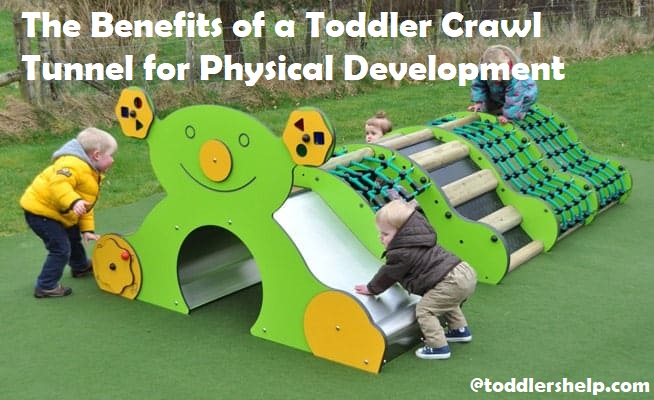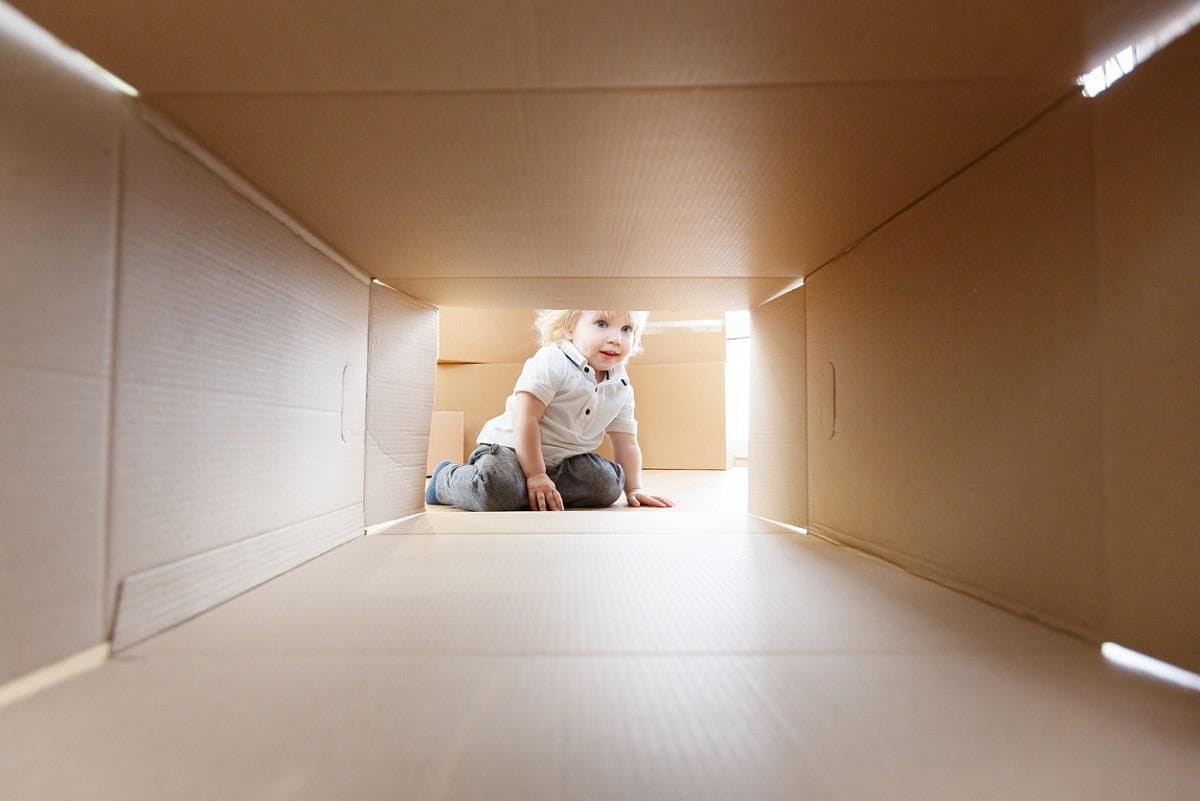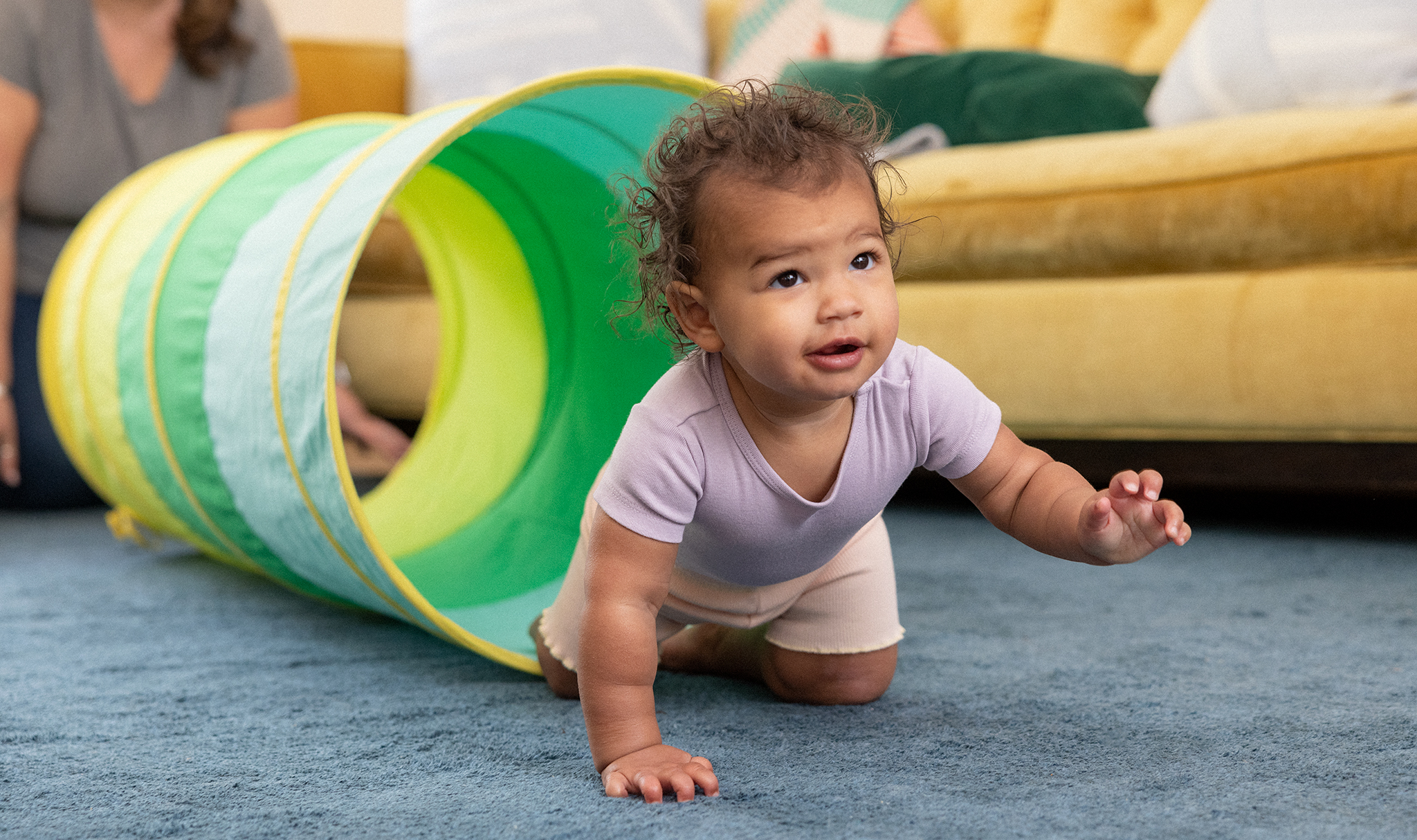Are you looking for ways to help your toddler become physically active? Watch them have endless fun and improve their physical development with a toddler crawl tunnel!
Read this guide to learn about the benefits of a crawl tunnel, how it can benefit your toddler, and the best way to use it. You won’t regret giving them this playful activity!
The crawling stage of development is a critical time for toddlers. Motion within the crawl tunnel helps improve their gross motor development and physical strength. Physical mobility and coordination are necessary to enable a child to explore their environment more independently and safely, leading to more experiences for learning.
Toddler crawl tunnels also allow fun creative play, stimulating imaginative play as well as reinforcing conventions of social behavior. It is important to understand the benefits these activities provide in order to ensure that children are being actively engaged in physical activity whilst having fun at the same time.
This Complete Guide explains the benefits of toddler crawl tunnels and how they contribute to physical development in detail.
Definition of toddler crawl tunnel
Toddler crawl tunnels are playful props used by parents and caregivers to encourage physical and cognitive development in young children. Typically made of soft materials, the tunnel typically has an oval or round shape and is long enough for a toddler to crawl through.
Usually the tunnels grow with a child since the openings at both ends can be adjusted from wide to narrow to make it more challenging as a child grows older.
Toddler crawl tunnels were created to introduce children to physical activity in an indoor setting where they are able to have fun while developing their balance, coordination, strength, sensory development, and motor skills.
Explanation of physical benefits for toddlers
Crawling is a critical part of early physical development, assisting with strengthening of the core muscles that are responsible for balance and coordination. The repetitive arm and leg movements involved in the crawling motion help to develop basic coordination skills. Additionally, a crawl tunnel helps toddlers to navigate around obstacles in their environment, preparing them for larger challenges such as climbing or hopping.
The physical benefits of playing in a tunnel are especially helpful for children with special needs, helping them build strength by increasing range of motion and building motor skills developments through an engaging activity that encourages exploration and further development. These tunnels provide resistance as the child crawls through them, allowing them to strengthen muscles that may be weaker than others from not having been used as extensively yet.
Not only do they help to increase physical development but they also offer educational advantages by stimulating problem solving skills by helping toddlers learn how to move past barriers within their environment, whether those barriers be stuffed animals or furniture placed within their play area. Further cognitive development is stimulated through cause-effect exploration as they crawl through the tunnel while alternating between motions such as crawling on all fours or belly-crawling down obstacles. Through this type of active play toddlers build on their physical skills while also developing emotional resilience.
Importance of physical development in early childhood
Physical development is an important factor in early childhood development that affects many aspects of a child’s overall health and well-being. Research shows that promoting physical activity among young children can lead to improved physical, cognitive, and psychological functioning. Additionally, it helps promote healthy lifestyle habits that will last a lifetime. Many activities are designed specifically to help build developmental skills in toddlers, one of which is the toddler crawl tunnel.
This guide explores the different benefits associated with toddler crawl tunnels, as well as how parents can make one at home for their own toddlers.
Crawl tunnels offer unique opportunities for motor development as they help children learn how to move through space and gain body awareness. As children progress through the tunnel, they must adjust their movements in order to fit through different sections. This helps them develop important skills such as coordination, strength, balance and agility; all necessary components of successful locomotion. The environment within the tunnel changes often – forcing the child to think on their feet while climbing in order to safely navigate around obstacles or adapt themselves accordingly when turning corners or going up inclines or declines.
Not only do tunnels provide a physical challenge – they also give children an opportunity to practice problem solving techniques independently and gain confidence in an environment outside of their comfort zone without parent supervision.
Additionally, crawling is great for strengthening core muscles both abdominals and back muscles–playing critical roles in overall postural control challenging hand-eye coordination needed for a multitude of gross motor tasks from rolling over uncoordinated infants up through playground sports like baseball or basketball with older kids – and developing shoulder girdle strength required for strong arm movements such as throwing a ball and pushing oneself off the floor into standing position.. Crawling also encourages body awareness essential for spatial learning – important when navigating potentially dangerous environments like streams or slippery rocks on family hikes – allowing kids understand where their own bodies exist within space without having visible reference points (like walls give adults indoors).
Physical Benefits of Toddler Crawl Tunnel
A toddler crawl tunnel is a fun, safe way to help your child develop important physical skills. By giving your child the opportunity to explore a crawl tunnel, you can help them develop strength and endurance, as well as balance and coordination.
Strength and Endurance: As your toddler moves through the tunnel, their muscles are engaged in the effort. This will help them develop strength and endurance in those muscles. This will give your child the ability to engage in physical activity for longer periods of time.
Balance and Coordination: Toddlers typically do not have great balance or coordination yet; as they move around inside the crawl tunnel, they have to learn how to keep their balance while maneuvering around obstacles like curves and bumps. With practice, your child’s balance and coordination will improve so they can safely take part in activities without falling easily or getting bruised up.
Reaction Time: As toddlers explore the crawl tunnel, they are using visual cues to determine what direction they need to move next. This helps their brains understand cause and effect — if I go within this direction there will be steps ahead — which can refine their reaction times when faced with different situations outside of the tunnel.
Enhances gross motor skills
Crawl tunnels can be an important tool for helping toddlers learn physical development milestones. Through climbing, crawing and pushing their way through the tunnel, toddlers can practice and develop the skills they need that are integral to obtaining more complex gross motor skills.
By using a crawl tunnel, toddlers will develop their coordination, balance and agility as they maneuver themselves through it. As they gain greater control over their movements, they will gradually become more confident in themselves and their abilities. Additionally, since moving through a crawl tunnel requires various muscles to be used in tandem, it helps build strength throughout the whole body leading to stronger core muscles as well as arm and leg muscles.
Promotes coordination and balance
A toddler crawl tunnel is a fun and interactive piece of play equipment that encourages physical development in young children. The tunnel helps promote coordination and balance as the toddler crawls through it and can have many other benefits as well.
Firstly, crawling is an important part of a toddler’s development as it strengthens their core muscles. Secondly, it encourages the use of both sides of the body at the same time which can help to improve fine motor skills. Thirdly, toddlers need to practice developing spatial awareness and problem solving skills when they are getting comfortable with their body in the tunnel.
Lastly, tunnels are a great way to build up strength while offering sensory activation. This can be especially beneficial for children with autism or other special needs who require more comprehensive sensory activities. By providing them with an engaging environment, toddlers have the opportunity to explore their physical capabilities in a safe and secure way.
Increases spatial awareness
Crawl tunnels offer a great sensory environment for toddlers as they explore the tactile experience of moving through the tunnel. Crawl tunnels can also help to increase spatial awareness and learning, as the child navigates the confined environment and begins to develop a better understanding of their own body in space.
Additionally, crawl tunnels help children learn nonverbal communication cues, such as learning how to navigate through a tight area without putting themselves or others in danger. This type of exploration can help increase problem-solving skills when it comes to figuring out how to move through a space efficiently while coordinating their body movements.
The encouragements and loud noises that often come along with exploring crawl tunnels can also enhance self-confidence in small children.
Choosing the Right Toddler Crawl Tunnel
A toddler crawl tunnel is a great way to help your little one develop his or her motor skills and physical abilities. In order to ensure that the tunnel serves its purpose, however, it is important to select the right kind for the job. There are several factors to consider when making your decision.
The Size: Make sure you choose one that is appropriate for your child’s age, size, and strength level. A larger tunnel can become cumbersome after a while and lead to frustration if not sized correctly. Look for a crawl tunnel that is wide enough and tall enough for your child to comfortably move through.
Safety Features: Look for reinforced edges and seams which are free of sharp points or edges that could be potential hazards. Also check for safe fabric materials which won’t irritate delicate skin or cause an allergic reaction. Some tunnels contain mesh-screen tops and side panels with breathable mesh material which can provide visibility and airflow – something important in such enclosed spaces.
Durability: Choose something sturdy with strong stitching a triple reinforced seam so it will hold up over time! The frame should be stable enough to provide necessary support during playtime activities but also lightweight enough so it can be easily moved around or taken on trips if needed. You should also check if the material used in construction is machine washable (or otherwise easy to clean) in order keep things neat and hygienic when needed as well!
Size and dimensions
When shopping for a toddler tunnel for physical development, consider the size and dimensions of the tunnel. Depending on your specific needs and space, your crawl tunnel should be appropriately sized to ensure kids are getting the most out of their playtime. Consider the height, width, and length of the crawl tunnels when determining which product is right for you.
The length is perhaps the most important factor when looking at dimensions; longer tunnels provide more opportunities for exploration. Look for tunnels that have an interior length of at least 6 feet or longer – this allows your little one more room to move around and explore all throughout their playtime! Consider buying a collapsible model with adjustable heights if ultimate flexibility is desired and need arises.
When thinking about width, look for ones with a generous internal circumference to allow plenty of room for movement inside the tunnel. The shape can also be an important consideration— oval tunnels provide more space in both width and height as kids move forward inside them. If you anticipate multiple kids wanting to access tube together, look out ones with bigger diameters so they can explore comfortably while playing together!
Material and safety features
When selecting a crawl tunnel for toddlers, there are material and safety features to consider. It’s important to choose a tunnel that is durable and has breathable mesh windows so you can observe your child’s progress during play. Look for soft edges with padding surrounding the frame to protect against bumps and bruises on impacts. Directional openings at the ends of the tunnel should be large enough for active little ones to easily crawl in and out. The fabric should be fade-resistant, machine washable materials, such as cotton or nylon.
Additionally, make sure the construction of the tunnel is strong enough to support a lively little one bouncing and pushing through it. Choose a well-made tunnel with reinforced seams that won’t tear or rip when it gets too much wear or if kids have extra gymnastic flair. You also want to make sure you select a toddler crawl tunnel with fire retardant properties for an extra layer of safety protection before play time begins!
Portability and storage
Toddler crawl tunnels are designed to be easily transported, making them an ideal choice for a day at the park or even in the backyard. They are light and can often fit into a backpack, so no matter how far you’re going, it’s easy to take your child’s tunnel with you. Plus, most are collapsible for convenience when it comes to storage.
When not in use, the crawl tunnel can be shunted away inside a closet or under the bed, taking up minimal space. With its portability and ease of storage it becomes easier to make this piece of toddler play equipment one of their regular physical activities.
Setting up a Toddler Crawl Tunnel
Setting up a toddler crawl tunnel is easy: you will only need the tunnel itself, or whatever materials you have chosen to create a crawl space, plus some padding and safety equipment to place at the entrance and exit of the tunnel. Here’s what you need to do.
- Create your space: Measure out where your toddler can safely crawl through the tunnel and make sure it’s large enough for them to move around comfortably inside. If possible, create a slight incline within the walls of the tunnel or incorporate any additional sensory cues such as fabrics with different textures or playful objects that they can reach and explore during their crawl.
- Place padding around entry/exit points: To prevent injury from bumping their head when getting into or out of the tunnel, be sure to place soft padding around its entry and exit points (don’t skimp on this step!). Plywood, foam blocks, pillows, carpet pieces – anything will work as long as it provides plenty of cushioning.
- Place additional safety items in surrounding area: The area surrounding your child should also be padded where possible (i.e., if furniture is nearby). You should also tether any toys within an arm’s reach that could pose a choking hazard or block their path while they are crawling. This will help keep your child safe while moving through their new environment (and give you peace of mind).

Conclusion
In conclusion, a toddler crawl tunnel can be a great tool to help your child develop their physical skills and have fun in the process. By challenging their coordination and balance, encouraging exploratory behavior, and giving them the opportunity to safely explore new environments, this simple toy can make remarkable improvements in your child’s motor development.
Furthermore, having exciting pathways to navigate adds an element of fun that inspires imagination and problem-solving. All of these features will help your child become a safe and confident explorer of the world as they grow up.
FAQ’S
What are the benefits of crawl tunnels?
Crawl tunnels can provide physical exercise, promote gross motor development, and encourage imaginative play for children.
What skills does crawling through a tunnel work on?
Crawling through a tunnel can work on a child’s gross motor skills, spatial awareness, balance, and coordination.
What is tunnel activity for babies?
A tunnel activity for babies involves crawling through a soft, padded tunnel that is safe and appropriate for their age and developmental stage.
Do toddlers like tunnels?
Many toddlers enjoy playing in tunnels as it provides a fun and exciting environment for them to explore and use their imagination.
What is the main purpose of tunnel?
The main purpose of a tunnel can vary depending on its use, but it is typically designed for transportation or as a passageway through a physical obstacle.
What purpose do tunnels serve?
Tunnels can serve a variety of purposes, such as providing transportation, creating underground storage spaces, or serving as part of a recreational or educational activity.
What is tunnel advantages and disadvantages of tunneling?
The advantages of tunneling can include improved transportation infrastructure and increased access to resources, while the disadvantages can include high costs and potential environmental impacts.
What are 3 facts about tunnels?
Three facts about tunnels are that they have been used for transportation for thousands of years, some of the world’s longest tunnels are used for water supply, and tunnels can be built through a variety of materials including rock, soil, and water.
How does crawling help physical development?
Crawling helps physical development by promoting the development of coordination, strength, balance, and overall body awareness. It can also help in developing gross and fine motor skills, such as crawling on hands and knees, using arms and legs to move forward and backward, and developing hand-eye coordination.
What are the exercise benefits of crawling?
The exercise benefits of crawling include strengthening the core, upper and lower body, improving flexibility, and promoting joint health. Crawling also helps to improve cardiovascular endurance and can be an effective way to burn calories. Additionally, crawling can enhance cognitive function, including spatial awareness, memory, and problem-solving abilities.
See Also-
- Best toddler booster seat
- Best toddler car toys
- Best toddler blanket
- Best toddler bike seat
- Best toddler basketball hoop

